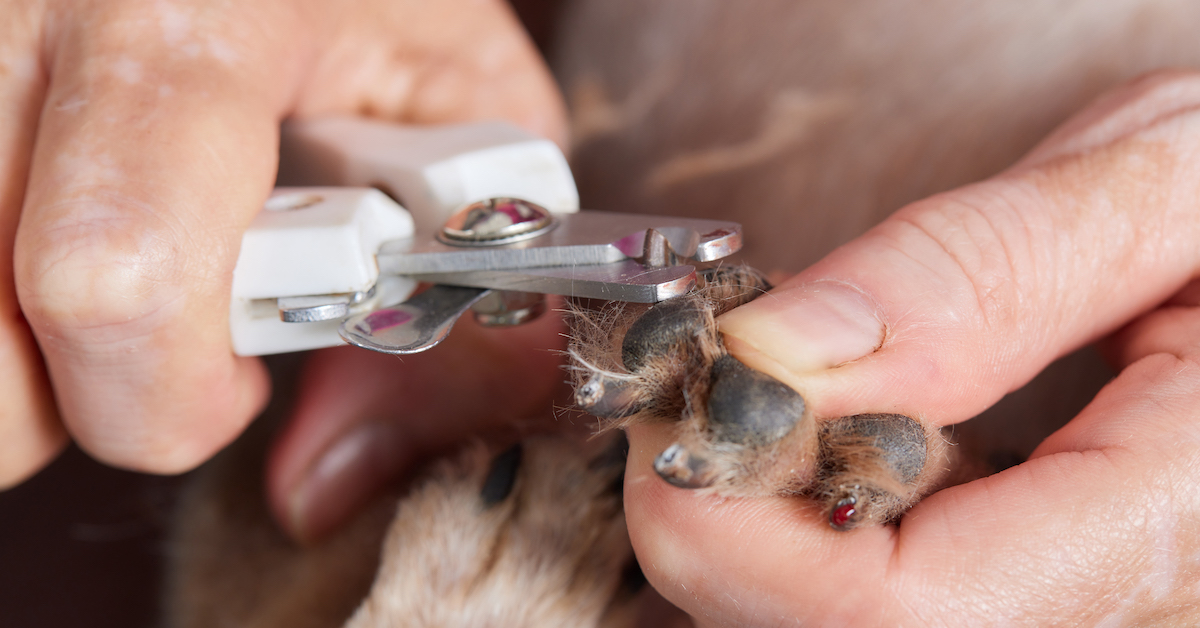How to Safely Trim Your Dog’s Nails at Home
Trimming your dog’s nails at home can save you money and ensure that his nails do not become overgrown.

It can get costly to bring your dog to the groomer for a nail trim every three to four weeks. Learning how to cut your dog’s nails at home can be a more convenient and affordable option.
You may have concerns about injuring your dog by cutting his nails too short, thus severing the “quick,” the sensitive part of the nail that contains nerves and blood vessels. Some dogs do not like their paws touched, which can make it even more difficult to achieve a clean cut.
Fortunately, there are ways to safely trim your dog’s nails at home. The right tools and techniques will allow you to safely trim your pet’s nails yourself.
Dangers of Long Nails in Dogs
Canines use their nails for a wide range of purposes. They are useful for digging in the dirt, grasping toys, scratching itchy spots, and even defending themselves against threats. In the wild, nails are ground down naturally by rough terrain; however, the same cannot be said for domesticated dogs.
Failure to trim your dog’s nails regularly can lead to a variety of health problems. Nails that are too long can cause excess pressure on your pet’s feet as the nails can push too far into the nail bed. The feet can start to swell, tendons can be damaged, and your dog can develop an unsteady gait. In addition, long nails can contribute to the development of arthritis, especially in senior dogs.
Nails that are too long also prevent your dog from putting his paw pads flat on the ground, increasing his risk of slipping, tripping, or falling. If the nails continue to grow without being trimmed, they can eventually curl and grow inwards, poking into the paw pads. When this happens, your dog can experience difficulty walking and chronic pain.
Getting Your Dog Comfortable
Many dogs are not comfortable having their nails trimmed. It takes a lot of time, patience, and practice to get pets used to clipping and grooming. There are several things that pet owners can do to help their dogs become more comfortable:
- Let him sniff the clippers. Pulling out a foreign tool and putting it near your pet’s feet can be a frightening experience for some dogs. For a few days or weeks before the first at-home trim, leave the clippers around where your dog can see and smell them.
- Touch the clippers to the paws. Once your dog has become comfortable around the clippers, take the next step which involves gently touching the clippers to the paws. Do not clip yet but simply make contact with the nails and paws for a few seconds at a time.
- Handle your dog’s feet often. It’s important to get your dog used to his paws being touched. When your dog is sitting with you on the sofa or the bed, take a few moments to handle and hold his paws to make them less sensitive to touch.
- Start slow with just one nail. Most dogs new to nail trims will not sit still long enough for you to cut all their nails. To make your dog more comfortable, start with just one nail and progress to more over time. Provide plenty of treats and praise with each nail trim.
How to Trim Dog Nails at Home
Before trimming your dog’s nails, you’ll want to gather your supplies. There are several types of nail trimmers on the market, including scissor, guillotine, plier, and grinder options. The type you choose will depend on your pet’s size, your comfort level, and your pet’s behavior during nail trims. You’ll also want to have some clotting powder nearby in the event that you hit your dog’s quick and it bleeds.
Next, find a comfortable position for both you and your pet. Depending on the size of your dog, you may find it easiest to wrap your arm around your dog and across the neck, firmly grasping one paw at a time. If your dog moves a lot during nail trims, it may be easier to have a second person hold the dog still while you cut his nails.
After finding a suitable position, gently grab your dog’s paw, placing your thumb on the toe pad and your forefinger on top of the toe to reveal the entire nail. Pressing gently into the pad will help extend the nail, allowing you to see the full length. With the nail in plain view, carefully examine the nail. It will be easier to see the quick in lighter-colored nails. If your dog has black nails, cut small amounts at a time to avoid the quick.
Cut your dog’s nails at a 45-degree angle to achieve the best results and to help you avoid the quick. While trimming your pet’s nails, don’t forget about the dew claws located on the side of the paws. Some dogs do not have dew claws or they were removed shortly after birth. Remember that dew claws are not ground down by walking outside and must be trimmed regularly to prevent them from getting too long and sharp.
Getting Help from a Professional
If you continue to struggle to trim your dog’s nails at home, don’t worry. This is a common occurrence and does not necessarily mean you are doing anything wrong. Groomers have experience working with dogs that are uncomfortable with trims. Consider bringing your pet to the groomer for regular trims. Your vet may also be able to prescribe an anti-anxiety medication for your dog to help reduce his fear of the clippers.
Ready to start saving money on pet wellness care?
Then take a look at Mint Wellness, the pet wellness plan that provides fast reimbursement on routine pet care. Save on vaccinations, wellness exams, preventatives, dental, and more!
Learn More


